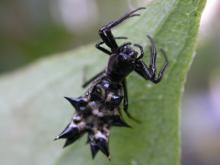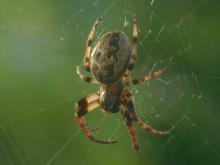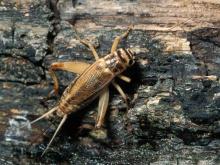Land Invertebrates
Media

Species Types
Scientific Name
About 6,500 species have been named so far, worldwide.
Description
Daddy longlegs, or harvestmen, are familiar Missouri animals. They are not spiders, but opilionids. Unlike spiders, they have a fused body form and lack silk and venom glands.
Media

Species Types
Scientific Name
Neriene radiata (formerly Prolinyphia marginata)
Description
The filmy dome spider is one of the most abundant woodland spiders in Missouri. Although the spider is tiny, its snare web, which looks like an upside-down silk bowl, is conspicuous throughout the year.
Media

Species Types
Scientific Name
Micrathena gracilis
Description
The color pattern can vary, but the ten-spined, chunky abdomen sets the female spined micrathena apart from all other spiders.
Media

Species Types
Scientific Name
Larinioides spp.
Description
Furrow orbweavers have a distinctive dark pattern on the abdomen that resembles a furrow. These harmless spiders are common under the eaves of homes and near porch lights.
Media

Species Types
Scientific Name
About 84 species in North America.
Description
Many blow flies are so shiny and colorful they’re called greenbottles and bluebottles. But pretty as they are, it’s hard not to be repulsed by their larval diets.
Media

Species Types
Scientific Name
Entypus aratus, E. unifasciatus, E. fulvicornis, and others
Description
Spider wasps in genus Entypus are bluish black and usually have some amount of amber color on their dark, smoky wings. Some species have bright yellow antennae.
Media

Species Types
Scientific Name
Rabidosa punctulata
Description
The dotted wolf spider has a solid brown stripe running down the middle of the abdomen, seen from above. Like other wolf spiders, females have strong maternal instincts, carrying their spiderlings around on their back until they can be on their own.
Media

Species Types
Scientific Name
Rabidosa rabida
Description
The rabid wolf spider, despite its scary name, is harmless to people and is absolutely not rabid. It commonly hides in leaf litter and sometimes gets into houses.
Media

Species Types
Scientific Name
About 1,000 species in North America north of Mexico
Description
Many apid bees are well-known. This family includes the familiar honeybee, bumblebees, and carpenter bees, plus many that are less well-known. With few exceptions, most of Missouri's apid bees are native, solitary species.
Media

Species Types
Scientific Name
Acheta domesticus
Description
House crickets are probably native to Eurasia but are found nearly worldwide, having traveled the globe with people. Unlike most other field crickets in our area, they are tan and brown instead of glossy black.
See Also



Media

Species Types
Scientific Name
Cisseps fulvicollis
Description
The yellow-collared scape moth is more often “orange-collared.” And whether you think it looks more like a firefly or a wasp, it’s still a moth!
Media

Species Types
Scientific Name
Nearly 150 species in North America north of Mexico
Description
Slim, delicate plume moths are instantly recognizable by their T-shaped silhouette, long legs, and muted shades of tan and brown. It can be hard to separate the various species.
Media

Species Types
Scientific Name
Pyrrharctia isabella
Description
Not many people know the adult Isabella tiger moth when they see one, but we’re all acquainted with its caterpillar, the woolly worm, or woolly bear.
About Land Invertebrates in Missouri
Invertebrates are animals without backbones, including earthworms, slugs, snails, and arthropods. Arthropods—invertebrates with “jointed legs” — are a group of invertebrates that includes crayfish, shrimp, millipedes, centipedes, mites, spiders, and insects. There may be as many as 10 million species of insects alive on earth today, and they probably constitute more than 90 percent all animal species.





















